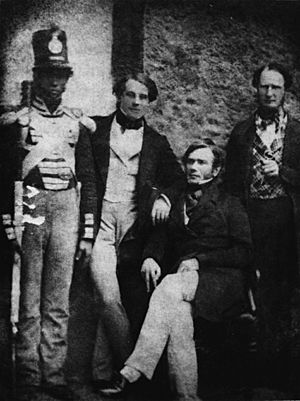Young Ireland rebellion facts for kids
Quick facts for kids Young Irelander Rebellion |
|||||||
|---|---|---|---|---|---|---|---|
| Part of the Revolutions of 1848 | |||||||
 Daguerreotype of Young Irelanders Thomas Francis Meagher and William Smith O'Brien (centre) in Kilmainham Gaol after the rebellion |
|||||||
|
|||||||
| Belligerents | |||||||
| Commanders and leaders | |||||||
| William Smith O'Brien |
|
||||||
| Strength | |||||||
| unknown | 47, unknown number of reinforcements arrived later | ||||||
| Casualties and losses | |||||||
2 killed:
|
|||||||
The Young Irelander Rebellion was a short uprising in Ireland. It was led by a group called the Young Ireland movement. This event was part of bigger changes happening across Europe in 1848. Many people in different countries wanted more freedom or their own governments.
The rebellion happened on July 29, 1848. It took place in a small area called Farranrory, near Ballingarry in County Tipperary. During the event, a group of Irish police officers, called the Irish Constabulary, were chased by the Young Irelanders. The police took shelter in a house and held the people inside as captives. A gunfight lasted for several hours. But the rebels left when many more police officers arrived.
This event is sometimes called the Famine Rebellion. This is because it happened during the terrible Great Irish Famine. It is also known as the Battle of Ballingarry or the Battle of Widow McCormack’s Cabbage Patch.
Contents
What Was the Young Irelander Rebellion?
The Young Irelander Rebellion was a small attempt by Irish nationalists to gain independence. Nationalists are people who want their country to be free and govern itself. The Young Ireland movement believed Ireland should be free from British rule. They hoped to start a bigger uprising.
This rebellion was part of the Revolutions of 1848. These were a series of protests and revolts across Europe. People wanted more rights and changes in how their countries were run.
Why Did It Happen?
The rebellion happened during a very difficult time in Ireland. The Great Irish Famine was causing widespread hunger and death. Many people were suffering. They felt that the British government was not doing enough to help. This made many Irish people very angry and frustrated.
The Young Ireland leaders felt that peaceful ways of asking for change were not working. They believed that a rebellion might be the only way to make a difference. They hoped that the suffering from the Famine would make people join their cause.
The Day of the Rebellion
On July 29, 1848, the leader of the Young Irelanders, William Smith O'Brien, was trying to gather support. He and his followers were in County Tipperary. A group of police officers from the Royal Irish Constabulary saw them. The police decided to arrest O'Brien.
The Young Irelanders chased the police. The officers ran into a house belonging to a woman named Widow McCormack. They held the family inside as captives to protect themselves. The rebels surrounded the house. A gunfight then began between the rebels and the police.
The Battle of Widow McCormack’s Cabbage Patch
The fight lasted for several hours. The rebels tried to get the police to surrender. However, the police held their ground. Eventually, a large group of police reinforcements arrived. When the rebels saw the extra police, they knew they could not win. They decided to leave and scattered.
Two rebels were killed during the fighting: Thomas Walsh and Patrick McBride. No police officers were killed. The rebellion ended quickly.
What Happened Next?
After the rebellion failed, many of the Young Ireland leaders were arrested. William Smith O'Brien and others were put on trial. They were found guilty of treason. Treason means betraying your country. Some leaders were sent away to other parts of the British Empire.
Even though the rebellion was small and failed, it showed the strong desire for Irish independence. It became an important part of Irish history. It inspired future generations to continue fighting for their country's freedom.

